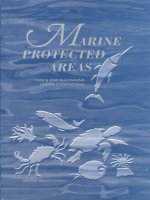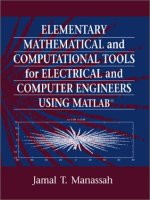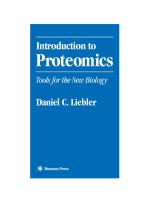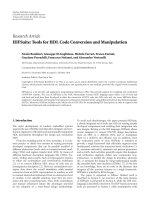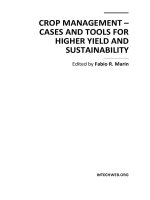Tools for Creating Accessible Math
Bạn đang xem bản rút gọn của tài liệu. Xem và tải ngay bản đầy đủ của tài liệu tại đây (971.24 KB, 45 trang )
Tools for Creating
Accessible Math
Presented by the DIAGRAM Center
Bryan Gould, Geoff Freed
WGBH National Center for Accessible Media
Steve Noble
University of Louisville
1.
2.
3.
4.
5.
6.
Introduction
Overview of Math Access and MathML
Speaking Math
Displaying and Reading Accessible Math
Tools for Creating MathML
Q&A
Digital Image And Graphic Resources
for Accessible Materials
• 5-year Research & Development Center
• Funded by Department of Education, Office of
Special Education Programs (OSEP)
• Awarded to Benetech along with partners:
• NCAM
• U.S. Fund for DAISY
•
•
•
•
•
•
•
•
•
(some of) DIAGRAM
Activities
Description guidelines training
Product evaluation matrices
User survey on reading technologies
Report on metadata images
SVG and 3D printing evaluation
Audio-Tactile usability study
Poet
Standard development: content model
Collaboration with Mathematics eText
Research Center (MeTRC, U. of Oregon)
diagramcenter.org
Accessible Digital Math
DOED OSEP Recommendation
June 22, 2012
NIMAS recommends ...MathML be used to improve
the accessibility of mathematical and scientific
content in core instructional materials ...as the
most effective method of providing accessible
print instructional materials involving
mathematical and scientific content to students
who are blind or who have print disabilities.
Pearson Higher Ed.
In 2014, every Pearson college math and stats text
will have an HTML eBook version
•
•
•
•
Formatted in HTML
MathML
Alt Text (image descriptions)
Readable by JAWS, Window-Eyes,
NVDA and other screen readers
Overview of Math Access
and MathML
universally recognized as one of greatest
achievements of the human mind and it can be
represented in the following equation:
a + b)
(
z=2
c
2
universally recognized as one of greatest
achievements of the human mind and it can be
represented in the following equation:
IMAGE!
universally recognized as one of greatest
achievements of the human mind and it can be
represented in the following equation:
Alt Text = “z equals 2
a plus b squared over
c”
Ambiguity
z equals 2 a plus b squared over c
a + b)
(
z=2
c
2
b
z= 2a +
c
2
fairly characterized as one of greatest
achievements of the human mind and can be
represented in the following equation:
Alt Text = “z equals 2
times the fraction open
parenthesis a plus b
close parenthesis
superscript 2 over c”
MathML
<math display='block'>
<semantics>
<mrow>
<mi>z</mi><mo>=</mo><mn>2</mn><msup>
<mrow>
<mfrac>
<mrow>
<mrow><mo>(</mo>
<mrow>
<mi>a</mi><mo>+</mo><mi>b</mi>
</mrow>
<mo>)</mo></mrow>
</mrow>
<mi>c</mi>
</mfrac>
</mrow>
Speaking Math
Speaking math: issues
• One size does not fit all – there is not just
one universal way to speak math
• In particular, the nature of a person’s print
disability will dictate some essential
parameters for effective math speech
• This is one reason why using MathML is
preferred over static alt text – the user’s
technology can use the best speech style
Speaking math: issues
• Concerns for two major populations –
blind vs. sighted with print disability
• Research studies underscore need for
unambiguous speech for blind students,
but more concise and natural (“plain
English”) speech for LD students
• Why?: Additional speech added for
disambiguation increases cognitive load
Speaking math: issues
• Example from Project SMART study
• Equation: P=2(L+W) was spoken as…
“Cap P equals two open cap L plus cap W
close”
• Although this style of speech is very
precise and useful for blind students, the
sighted LD students encountered
problems due to increased cognitive load
and unfamiliar verbalization
Speaking math: speech styles
• Simple Speech – default speech style used
in MathPlayer (modified by target setting)
• MathSpeak – specific speech style for
blind individuals accustomed to reading
Nemeth braille code
• ClearSpeak – currently in consumer
validation trials by ETS; makes extensive
use of prosody and familiar math speech
found in classroom settings
Speaking math: other issues
• K-12 Education: Instruction vs.
assessment – impact on construct validity
• Differences between State math reading
guidelines – Example: 8
Georgia, “radical eight”; PARCC “square
root of eight”
• Navigation: browsing a complex equation
– moving by digestible chunks
• Multi-language support
Displaying and Reading
Accessible Math
Accessible math: images
• Images of math are made accessible using
@alt and/or long descriptions (e.g.,
@longdesc, aria-describedby or other
markup)
• If you use images of math you must at a
minimum include @alt


